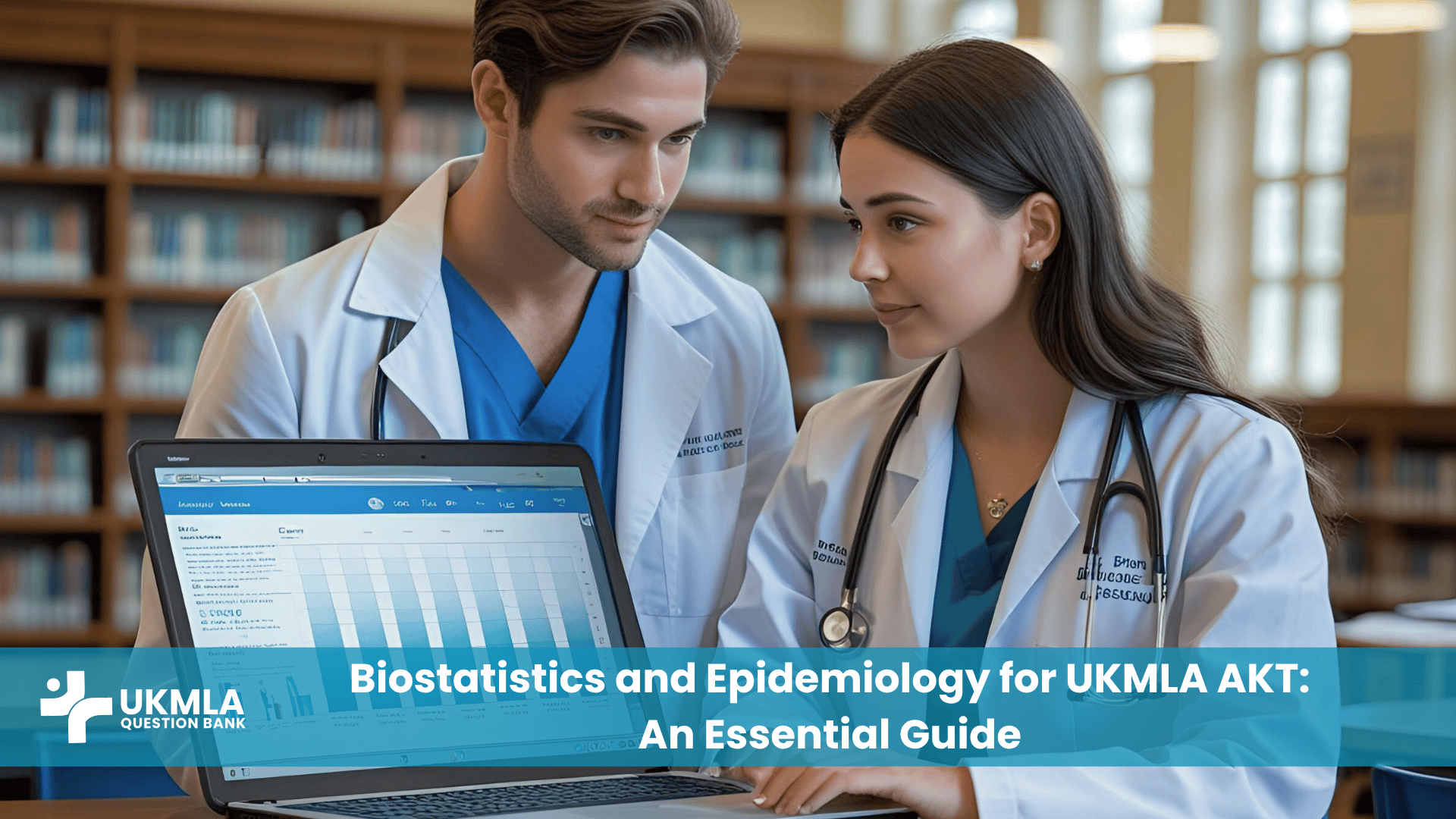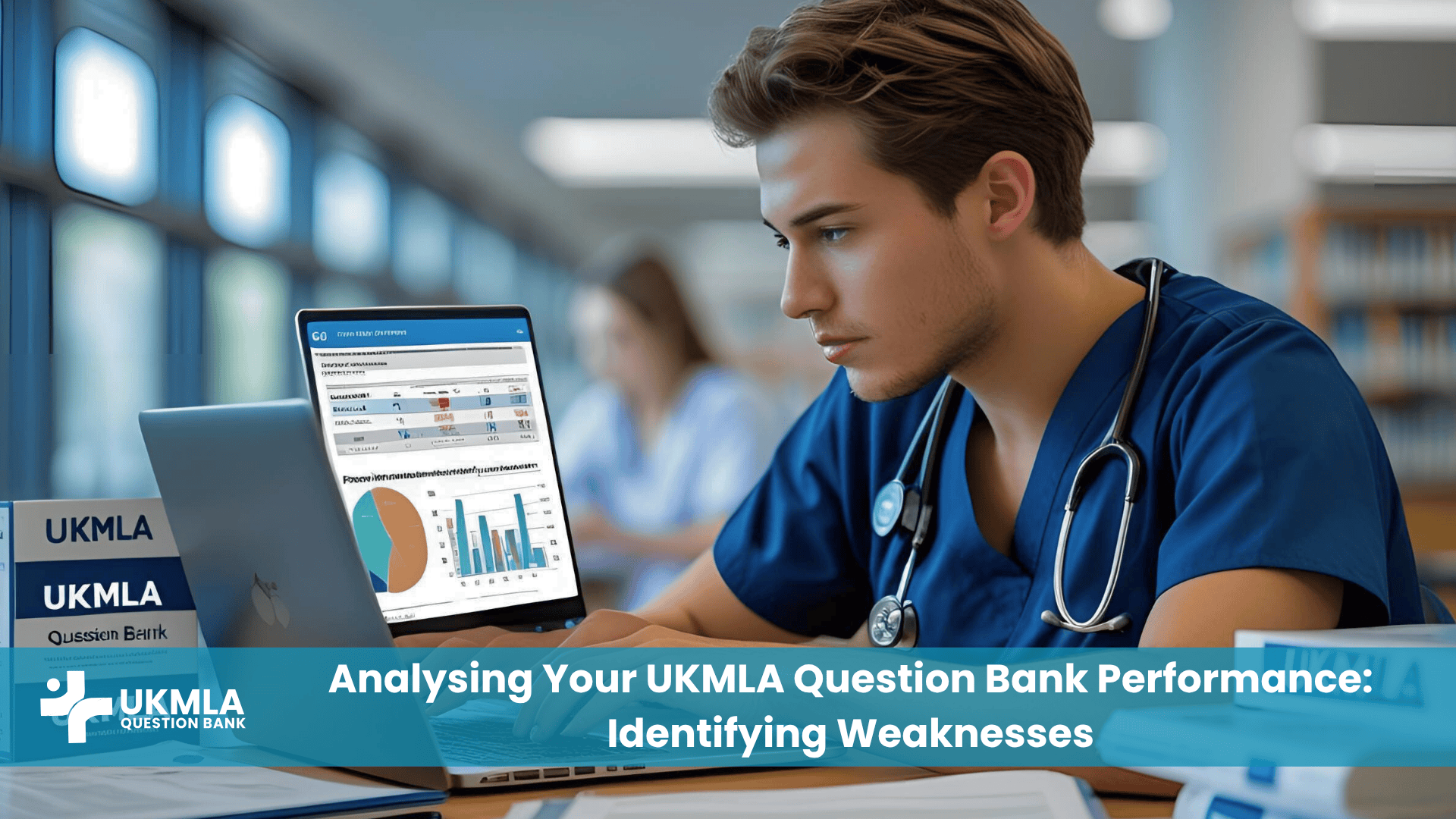Introduction
Understanding the core principles of biostatistics and epidemiology for UKMLA success is not just an academic exercise; it’s a fundamental requirement for any competent, evidence-based doctor. While these topics can seem intimidating compared to clinical medicine, the UK Medical Licensing Assessment (UKMLA) will absolutely test your ability to interpret medical literature, understand study designs, and critically appraise evidence. These skills are central to the “Areas of Professional Knowledge” domain outlined by the GMC (General Medical Council).
This guide is designed to simplify this complex subject. We will demystify the jargon and provide you with a clear, logical framework to approach any question related to biostatistics and epidemiology in the AKT (Applied Knowledge Test). Forget complex calculations; the UKMLA is about your ability to think critically. This guide will show you how.
Key Takeaways
Focus on Interpretation, Not Calculation: The UKMLA tests your ability to critically appraise study results and interpret data, not your ability to perform complex statistical calculations from scratch.
Know the Hierarchy of Evidence: Understand the key differences, strengths, and weaknesses of major study designs, from case-control studies up to randomized controlled trials (RCTs) and meta-analyses.
Master P-values and Confidence Intervals: Remember that a p-value < 0.05 indicates a statistically significant result. Crucially, a 95% Confidence Interval for an Odds Ratio or Relative Risk that does not cross 1.0 also indicates statistical significance.
Differentiate Key Terms: Be confident in explaining the difference between Incidence (new cases over time) and Prevalence (total cases at one point in time), as well as Relative Risk (for cohort studies) and Odds Ratio (for case-control studies).
Appraise Evidence Systematically: When looking at a study, always ask three core questions: 1) Are the results valid (is there bias)?, 2) What are the results (how large is the effect)?, and 3) Will the results help my patients (are they applicable)?.
Core Concepts in Epidemiology
Epidemiology is the science of how often diseases occur in different groups of people and why. For the UKMLA, you need to understand the tools used to measure this.
Study Designs: The Hierarchy of Evidence
Not all evidence is created equal. Understanding the main study designs and their position on the “hierarchy of evidence” is a high-yield topic.
Table 1: Key Study Designs and Their Characteristics
| Study Design | Key Feature | Main Strength | Main Weakness |
|---|---|---|---|
| Systematic Review & Meta-Analysis | Pools results from multiple studies. | Highest level of evidence; increases statistical power. | Can be flawed if individual studies are poor quality. |
| Randomised Controlled Trial (RCT) | Compares an intervention group to a control group, with random allocation. | Gold standard for determining causality; minimises bias. | Expensive, can have ethical limitations. |
| Cohort Study | Follows a group of people (a cohort) forward in time to see who develops a disease. | Excellent for determining prognosis and risk factors. | Time-consuming, not good for rare diseases. |
| Case-Control Study | Starts with people who have a disease (cases) and looks back in time for exposures, comparing them to people without the disease (controls). | Quick and cheap; good for rare diseases. | High risk of recall bias. |
| Cross-Sectional Survey | Measures exposures and outcomes at a single point in time. | Provides a “snapshot” of prevalence. | Cannot determine causality (cause and effect). |
Measures of Disease Frequency
Prevalence: The proportion of a population that has a disease at a specific point in time. Think of it as a snapshot. (e.g., “The prevalence of diabetes in the UK today is…”).
Incidence: The rate of new cases of a disease in a population over a specific period of time. Think of it as a video. (e.g., “The incidence of influenza this winter was…”).
Measures of Association
Relative Risk (RR): Used in cohort studies. An RR of 2 means the exposed group is twice as likely to develop the disease as the unexposed group. An RR of 1 means no difference.
Odds Ratio (OR): Used in case-control studies. It’s an estimation of the relative risk. An OR of 2 means the odds of having the exposure were twice as high in the cases compared to the controls.
Core Concepts in Biostatistics for the UKMLA
Biostatistics is the tool that epidemiology uses to draw meaningful conclusions from data.
Understanding Data: Types and Distributions
categorical datacontinuous datanormal (or Gaussian) distribution
The Language of Hypothesis Testing
biostatistics and epidemiology for UKMLA
Null Hypothesis (H₀): This is the default assumption that there is no difference between the groups being compared (e.g., the new drug works no better than the placebo). The goal of a study is often to see if there is enough evidence to reject this null hypothesis.
p-value: The probability of observing your results (or more extreme results) if the null hypothesis were true. A small p-value (conventionally p < 0.05) suggests the observed result is unlikely to be due to chance alone, so we reject the null hypothesis and say the result is “statistically significant.”
Confidence Interval (CI): This gives a range of plausible values for the true effect in the population. A 95% CI means we are 95% confident that the true value lies within that range. If the 95% CI for a relative risk or odds ratio crosses 1 (e.g., 0.8 – 2.5), the result is not statistically significant because a value of 1 (no effect) is a plausible result.
Clinical Pearl: “Statistical significance is not the same as clinical significance. A study of 100,000 people might find a new drug lowers blood pressure by 1 mmHg with a p-value of 0.001. The result is statistically significant, but a drop of 1 mmHg is not clinically significant or meaningful for the patient.”
Key Statistical Tests and When to Use Them
T-test: Used to compare the means of a continuous variable between two groups (e.g., comparing the mean blood pressure between a drug group and a placebo group).
Chi-squared test: Used to compare proportions of a categorical variable between two or more groups (e.g., comparing the proportion of patients who recovered in a drug group vs. a placebo group).
For more on interpreting results, our guide on interpreting clinical data in the UKMLA AKT is highly relevant.
Critical Appraisal: A Practical Framework
Critical appraisal is the skill of systematically evaluating a research paper to assess its trustworthiness, value, and relevance.
A Doctor’s Mindset: “Evidence-based medicine does not mean blindly following the results of a single study. It means applying the best available evidence, filtered through your clinical expertise and the patient’s individual values.”
A simple framework for appraising any paper involves three questions:
Are the results of the study valid? This is about looking for potential bias (systematic error). Was the allocation of patients to groups truly random? Were patients and doctors blinded to the treatment?
What are the results? How large is the treatment effect (the relative risk or odds ratio)? How precise are the results (what do the confidence intervals show)?
Will the results help my patients? Were the patients in the study similar to my own patient? Are the benefits of the treatment worth the harms and costs?
A fantastic set of tools to help you with this are the CASP (Critical Appraisal Skills Programme) Checklists, which provide simple, question-based guides for different study types.
Frequently Asked Questions (FAQ): Biostatistics & Epidemiology for UKMLA
These relate to diagnostic tests. Sensitivity is the ability of a test to correctly identify those with the disease (a highly sensitive test has few false negatives). Specificity is the ability of a test to correctly identify those without the disease (a highly specific test has few false positives).
PPV is the probability that a patient with a positive test result actually has the disease. NPV is the probability that a patient with a negative test result actually does not have the disease. Unlike sensitivity/specificity, these values are affected by the prevalence of the disease in the population.
A forest plot is a graphical representation of the results of a meta-analysis. It shows the results of individual studies as squares with confidence interval lines, and a diamond at the bottom representing the pooled, overall result. If the diamond does not cross the vertical line of “no effect” (usually at 1), the result is statistically significant.
No. The UKMLA is not a maths exam. You will not be asked to perform a t-test or calculate a standard deviation from scratch. You will be expected to interpret the results of these tests when they are presented to you.
SD tells you about the spread or variability of data within a single sample. A large SD means the data points are very spread out. SEM tells you how precise your estimate of the population mean is. SEM is always smaller than SD. Exam questions may test your understanding of this difference.
Bias is a systematic error in a study that leads to an incorrect result (e.g., selection bias, recall bias). Confounding is when a third factor is associated with both the exposure and the outcome, distorting the relationship between them (e.g., the link between coffee drinking and heart disease might be confounded by smoking, as coffee drinkers are more likely to smoke).
NNT is the number of patients you would need to treat with a specific intervention to prevent one additional bad outcome. A low NNT indicates a more effective treatment. It is calculated as 1 / Absolute Risk Reduction (ARR).
Focus on the most common ones. Selection bias (groups being compared are not similar), Recall bias (people with a disease remember past exposures differently from those without), and Observer bias (investigators assess outcomes differently if they know which group the patient is in).
It’s a graph used to show survival over time for different groups in a study (e.g., a drug group vs. a placebo group). You should be able to look at the curves and see if there is a difference in survival between the groups.
The best way is to actively practice. Use a high-quality UKMLA question bank and when you encounter a question with stats, don’t just look at the answer. Go through the abstract and ask yourself: What was the study design? What are the main results? Is there any bias? This active approach to biostatistics and epidemiology for UKMLA is the key to success.
Conclusion & Call to Action (CTA)
Ultimately, mastering biostatistics and epidemiology for UKMLA is about developing your critical thinking. The exam does not expect you to be a statistician; it expects you to be an intelligent and critical consumer of medical evidence, which is a fundamental skill for a modern doctor.
By understanding the core principles of study designs, the language of hypothesis testing (p-values and confidence intervals), and the basics of critical appraisal, you can turn this daunting topic into a source of confidence. Use the frameworks in this guide to systematically deconstruct questions, and you will find they are far more logical and less intimidating than they first appear.
Ready to apply these frameworks to realistic UKMLA-style questions? Test your skills with the comprehensive question bank and master the art of critical appraisal before your exam.




